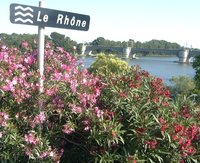|
|
The River Rhône (French Rhône, Occitan Ròse, Franco-Provençal Roun, standard German Rhone, Valais German Rotten) is one of the major rivers of Europe, running through Switzerland and France.
| Contents |
Origin of the name
Starry_Night_Over_the_Rhone.jpg
The word "Rhône" comes from Latin Rhodanus, which itself comes from ancient Greek οδανός (Rhodanos), which is the Greek rendering of the Gaulish (Celtic) name of the river, as heard by the Greeks living in the colony of Massalia (Marseille). The Celtic name of the river, something like Rodo or Roto, literally "that which rolls", or "that which runs", is a frequent name of rivers in the ancient Celtic tongue. It was also the name of the lower Seine River (see Seine article), as well as several other rivers of western Europe. This Celtic name comes from the Proto-Indo-European root *ret- ("to run, roll"), which gave the word rota ("wheel") in Latin, from which is derived "rotate" and "to roll" in English. Cognates in modern Celtic languages are Irish rith and Welsh rhedeg, both meaning "to run".
Some scholars posit that the root rot- or rod- found in the name "Rhône" as well as in the name of many western European rivers, and whose original meaning seems to be "river", is in fact Pre-Indo-European, in which case it would only be a coincidence that it resembles the Proto-Celtic verb reto ("to run"). Further research is needed to decide between these two theories.
In French, the adjective derived from the river is rhodanien, as in le sillon rhodanien (literally "the furrow of the Rhône"), which is the name of the long straight Saône and Rhône rivers valley, a deep cleft running due south to the Mediterranean and separating the Alps from the Massif Central.
Course
It rises near the Rhône Glacier in Valais, Switzerland, in the Saint-Gotthard massif, at an altitude of 1753 m.
Up to Martigny, the Rhône is a torrent, and then becomes a great mountain river running SW through a glacier valley. Then, it turns NW to exit the Alps and flows west through Lake Geneva (French Lac Leman) before entering France.
Rhone_vs2.jpg
Rhone_vs.jpg

Rhône_from_bridge_(medium).jpg
Rhône,_château_de_Beaucaire.jpg
It is joined by the river Saône at Lyon, before going south.
At Arles, the Rhône divides itself in two arms, forming the Camargue delta, with all branches flowing into the Mediterranean Sea. One arm is called the "Grand Rhône", the other one is the "Petit Rhône".
Tributaries
- Arve River (L)
- Ain River (R)
- Saône (R)
- Isère River (L)
- Drôme River (L)
- Ardèche River (R)
- Gard River (R)
- Durance River (L)
Power & speed
Though not the longest, the Rhône is the fastest and most powerful river in France.
An average of 1800 m3/s of water pours into the Mediterranean at its delta. This puts it at number 48 in the world ranking. However, heavy rain can cause the river to swell to dangerous proportions. For example, the rate was 11,000 m3/s at Beaucaire in January 1994.
Along the Rhône
Cities and towns along the River Rhône include:
Switzerland
- Brig (Valais)
- Sion (Valais)
- see Lake Geneva for a list of Swiss and French towns around the lake
- Geneva (Geneva)
France
- Lyon (Rhône)
- Vienne (Isère)
- Tournon-sur-Rhône (Ardèche)
- Valence (Drôme)
- Montélimar (Drôme)
- Orange (Vaucluse)
- Avignon (Vaucluse)
- Villeneuve-lès-Avignon (opposite Avignon) (Gard)
- Beaucaire (Gard)
- Tarascon (opposite Beaucaire) (Bouches-du-Rhône)
- Arles (Bouches-du-Rhône)
History
The river was a trade route since prehistoric times, helping to link Northern Europe to the Mediterranean.
See also
External link
- Waterways in France (http://www.discoverfrance.net/France/DF_waterways.shtml)
de:Rhône
et:Rhône es:Ródano fr:Rhône it:Rodano (fiume) lb:Rhône (Floss) nl:Rhône pl:Rodan sv:Rhône zh:隆河
